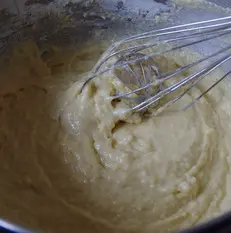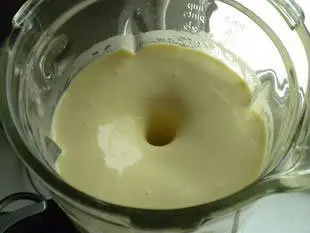This site uses only a few technical cookies necessary for its operation. By continuing to browse, you accept their use.
To find out more...
To find out more...
How to avoid lumps

You've probably come across this unpleasant phenomenon where, when you try to incorporate an ingredient (usually a solid or powder) into a preparation (usually a liquid), the mixture doesn't mix properly and you end up with little "balls" or little lumps of the solid part that refuse to mix with the liquid part.
A classic example is when you add flour to a pancake batter (for example), and you end up with lots of little white dots in your batter. It's very annoying, and you need a lot of elbow grease to get rid of them, if you manage at all.
A classic example is when you add flour to a pancake batter (for example), and you end up with lots of little white dots in your batter. It's very annoying, and you need a lot of elbow grease to get rid of them, if you manage at all.
23 K 4.8/5 (18 reviews)
Keywords for this post:LumpsDoughApparatusMixingWhiskLast modified on: October 9th 2020
How to avoid lumps
How can you avoid those famous lumps?
Here's a list of possible actions: 1) If you're incorporating a powdery ingredient (flour, almond powder, etc.), you need to sift the powder in question before incorporating it.
1) If you're incorporating a powdery ingredient (flour, almond powder, etc.), you need to sift the powder in question before incorporating it.
Don't hesitate to sift together several or all the powders in a recipe, for example for a cake: flour + sugar + yeast.
 2) For mixing, use a whisk instead of a maryse, spoon or spatula, as it mixes much better.
2) For mixing, use a whisk instead of a maryse, spoon or spatula, as it mixes much better.
 3) If, despite this, you're still faced with lumps, as a last resort, the mixer is your friend: giving your dough in preparation a good blow will liquefy it in a matter of seconds.
3) If, despite this, you're still faced with lumps, as a last resort, the mixer is your friend: giving your dough in preparation a good blow will liquefy it in a matter of seconds.
But don't use it on dough containing whipped cream or egg whites, as you'll destroy the airiness of the mixture.
What if it's not a powder you're mixing in?

You can use the same lifesaving gestures, but your problem probably stems from too great a temperature difference between the dough you're mixing in and the butter, and the latter congeals and clumps together.
The trick is to keep mixing, placing your dough in a bain-marie that's not too hot, or if possible, putting it in the microwave for 20-30 seconds.
To sum up: to avoid lumps with powders: sift, whisk, mix, and with fats: the same, but pay attention to temperature differences.
Lasts posts
Butter vs. grease
We often read in a recipe where a pastry is put into a mould that, just before pouring, the mould should be buttered or greased. But what's the difference between these 2 terms?December 1st 20251,2045
Getting out of the fridge early
Very often when you're cooking, you need to take food or preparations out of the fridge, to use them in the recipe in progress. There's nothing tricky about this: you just take them out of the fridge and use them, usually immediately, in the recipe. But is this really a good method?November 24th 20251,2085
Who's making the croissants?
When you look at a bakery from the outside, you naturally think that in the bakery, the bakers make the bread, and in the laboratory, the pastry chefs make the cakes. It's very often like that, with each of these professions having quite different ways of working, but sometimes there's also one...November 23th 20251,102
Oven height
When we put a dish or cake in the oven, we naturally tend to put it on the middle shelf, and that's what we usually do. But in some cases, this position and height can be a little tricky, so let's find out why.October 8th 20252,9985
The importance of sieving
In recipes that use a fine powder (flour, powdered sugar, etc.), you'll often see the advice to sift before using it. To sift is to pass the powder in question through a sieve (a very fine strainer) before incorporating it into your recipe. It's often advice, but is it really useful?September 3rd 20257,7033
Other pages you may also like
Candied fruits: don't get ripped off
Do you like candied fruit? You might like to nibble a handful or add it to a recipe, like a classic fruit cake or delicious Italian specialities like panettone or sicilian epiphany pie.June 21th 201767 K 24.2
The so-called "nervous" meats
You've probably heard this before, we're talking about "nervous" meat, or meat with nerves, to describe what is indicated by the blue arrow on the left. This is a piece of beef, and what we call a nerve is not a nerve, it is in fact collagen (chemists sometimes call it a "collagen sink"), a...April 16th 202137 K4.5
A few tips for effective kneading at home
When you have to knead dough for bread or some other recipe, you may well use a food processor or the type of machine known as a stand mixer. The best-known brands are Kenwood and KitchenAid. They are useful tools, but here are a few tips to help you get the best out of them.June 23th 2021284 K 23.8
Egg yolks and caster sugar
We often come across recipes where we need to mix egg yolks with caster sugar. This would appear to be a very ordinary and simple thing to do but, be warned, these two ingredients can behave oddly together.February 15th 201883 K 24.3
How to break eggs properly?
It is a very common gesture in pastry, bakery and of course cooking: breaking eggs to incorporate them into a recipe. You have eggs (which professionals call "shell eggs" to differentiate them from liquid eggs in cartons or cans), and you must break them to incorporate the contents into your...June 26th 202115 K4.8
Post a comment or question
Follow this page
If you are interested in this page, you can "follow" it, by entering your email address here. You will then receive a notification immediately each time the page is modified or a new comment is added. Please note that you will need to confirm this following.
Note: We'll never share your e-mail address with anyone else.
Alternatively: you can subscribe to the mailing list of cooling-ez.com , you will receive a e-mail for each new recipe published on the site.









